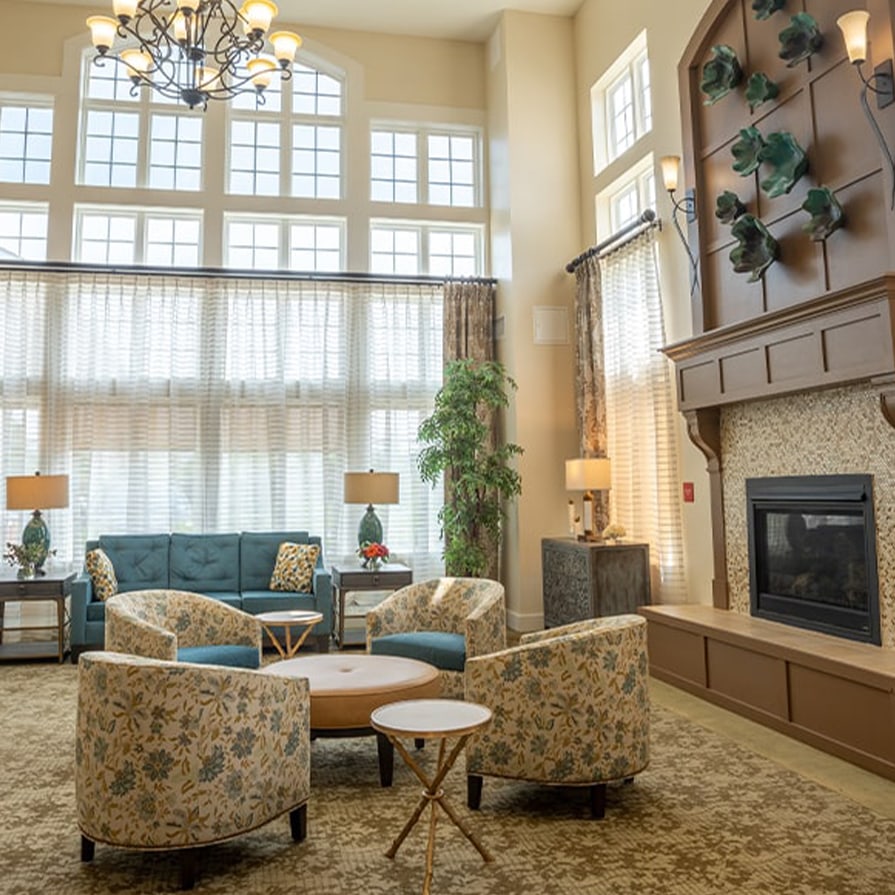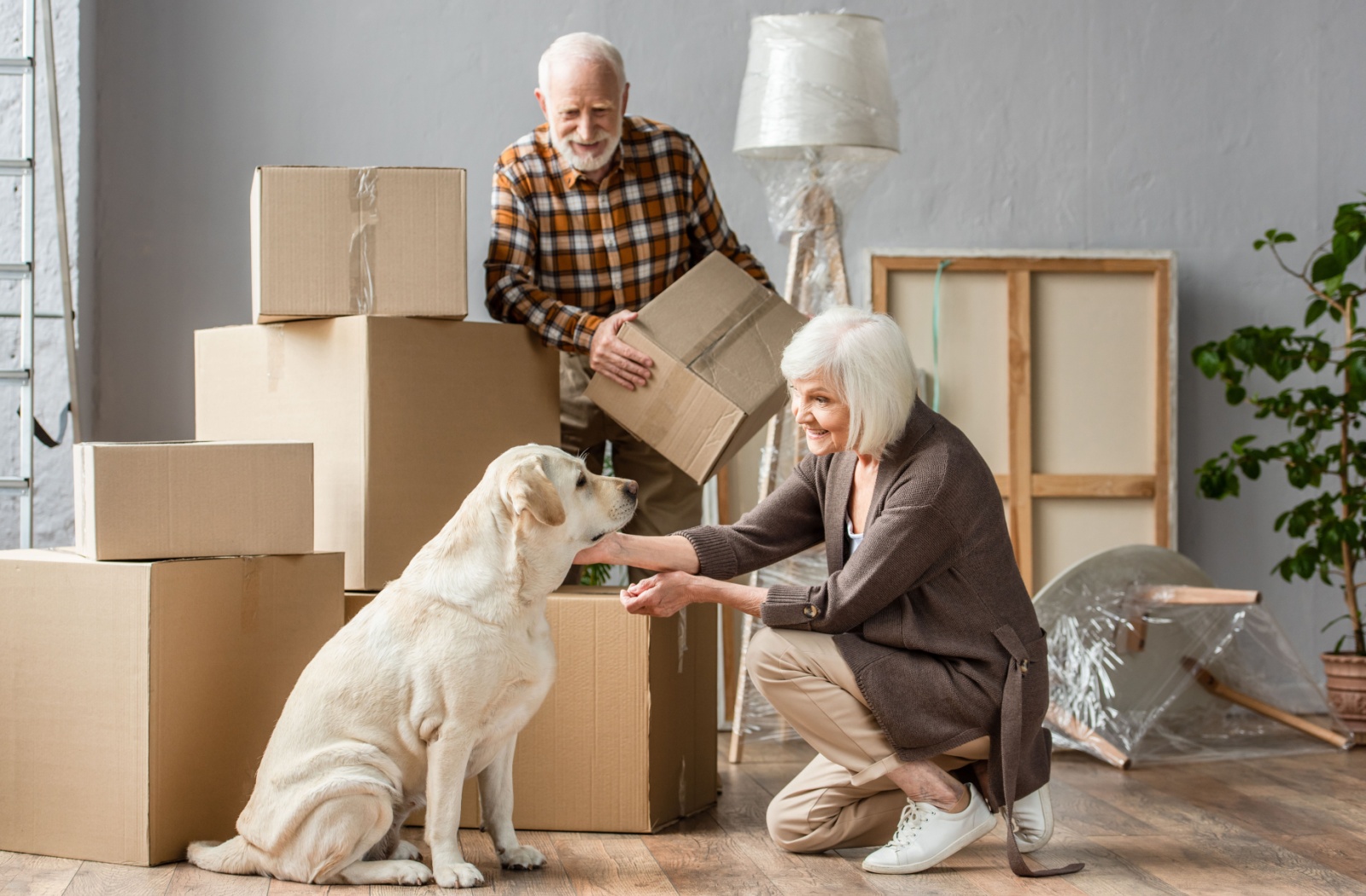Moving to an independent living community is an exciting new chapter, offering opportunities for connection, convenience, and support. But for older adult pet owners, one question often lingers amidst the excitement: How can I help my pet adjust to this transition?
Pets are more than companions, they’re family. Naturally, you want their transition to be as seamless and comfortable as your own. Fortunately, with a bit of preparation and patience, you and your furry friend can thrive together in your new environment by acclimating before the move, minimizing changes to their surroundings, and gradually introducing them to new things.
How Pet Ownership Benefits Older Adults
Pets provide so much more than companionship. For older adults, they can be a source of joy, unconditional love, and even health benefits.
Research indicates that owning a pet can help reduce stress, lower blood pressure, and promote physical activity. Dogs may inspire regular walks, while cats often provide calming companionship. Pets also foster a sense of routine and purpose, which can be particularly grounding during times of life transition.
For many older adults, pets are their lifeline to happiness and vitality. That’s why it’s so important to take steps to ensure their pet’s well-being during a move.
How to Prepare Your Pet Before the Move
Preparation is key when planning a move with your pet. Taking proactive steps can help minimize stress for both of you.
1. Acclimatize Your Pet to Change
Well before moving day, begin acclimating your pet to new experiences. Set up its carrier or crate in a familiar space, leaving it open so it can explore it at its own pace. If you’re downsizing and bringing new furniture, introduce those items into your space so they become part of your pet’s environment.
Consider taking short trips in the car if travel will be part of your move. Practice can help pets feel more secure on the big day.
2. Maintain Their Routine
Pets thrive on routine. Even amidst the chaos of packing, stick to their feeding, walking, and play schedules. Familiarity provides comfort.
3. Prepare for Travel Day
When travelling a long distance, be sure to pack plenty of food, water, toys, and any necessary medications for your pet. For dogs and cats, secure them in an appropriately sized carrier for safe travel. For smaller animals, such as birds or rabbits, ensure their transport cage is both safe and comfortable.
4. Update Their Information
Double-check that your pet’s ID tags and microchip details are updated with your new address. This small action ensures you can be reunited quickly if your pet becomes lost during the transition.
5. Find a Vet Near the Community
Research veterinarians in the area of your new independent living community. It’s always helpful to know the location of the nearest clinic in case of an emergency.
How to Support Your Pet on Moving Day
Moving day can be particularly overwhelming for pets, as they encounter new sights, smells, and activities all at once. Here’s how to make it easier on them— and you.
- Set Up a Quiet Space: Keep your pet in a calm, quiet area while movers come and go. Designate a cozy room with their bed, toys, water, and maybe even some relaxing music.
- Minimize Changes: Where possible, keep their familiar items around them. Moving their favourite bed or blanket into the new space as is will help maintain a sense of consistency.
- Stay Calm: Your energy directly affects your pet. Try to remain as calm and positive as possible. Offer reassurance with a soothing voice and calming pats to let them know everything is okay.
Ensuring a Smooth Transition for Your Pet Post-Moving Day
Once the move is complete, turn your attention to settling your pet into the new environment.
1. Establish a Routine
Reinstate your pet’s regular feeding, exercise, and play schedule as soon as possible. Predictability helps your pet feel secure.
2. Create a Sanctuary
Designate a specific area in your new home just for your pet. Fill it with their familiar belongings, and gradually introduce new items to help them acclimate.
3. Introduce Them to the New Environment Slowly
Allow your pet to explore the new space on their own. For example, initially introduce them to one room at a time before letting them roam freely.
4. Use Positive Reinforcement
Reward your pet when they respond well to the new environment. A favorite treat or extra belly rubs can create positive associations with the change.
5. Engage with Other Residents
Many pet-friendly communities bring together like-minded individuals who share a passion for pets. Take advantage of group walks, playdates, or resident pet events to help your pet feel comfortable and build connections.
6. Be Patient
Every pet acclimates at their own pace. Some may settle in right away, while others may need a few weeks. Be patient and give them the time and support they need.
How Pet-Friendly Independent Living Communities Benefit Older Adults
Pet-friendly independent living communities are designed to cater to both residents and their beloved animals. These communities recognize the vital role pets play in fostering a happy and fulfilling retirement.
Here’s how they benefit older adults and their pets:
- Social Connections: Pets serve as natural conversation starters. Walking your dog around the community or chatting about pet stories can quickly help you build relationships with fellow residents.
- On-Site Amenities: Many communities offer pet-friendly amenities, including dog parks, walking trails, and grooming facilities, ensuring pets are comfortable and well-cared for.
- Support Systems: Staff at pet-friendly communities are typically well-equipped to assist with pet needs, such as recommending nearby veterinary services or offering guidance on caring for aging pets.
- Improved Quality of Life: By fostering a welcoming environment for pets, these communities enhance the overall happiness and quality of life for residents.
Your Next Chapter Together
Moving to an independent living community is an opportunity to build new memories, friendships, and experiences with your beloved pet by your side.
Juniper Village at Brookline encourages all future residents to plan ahead and provide support for their pets, ensuring a smooth transition for both of you. Contact us today to learn about our pet-friendly policies.







